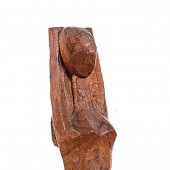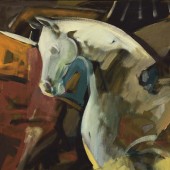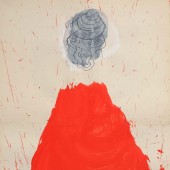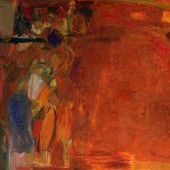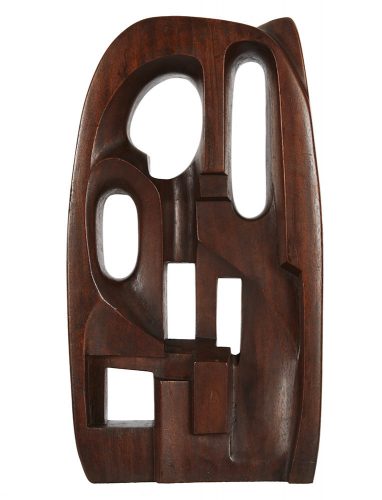
Lebanese painter and sculptor Saloua Raouda Choucair is acclaimed for her unique visual language and deeply intellectual approach that draws on mathematics, philosophy, science, Islamic art, architecture, spirituality, and modernism. Using an algorithmically generated method, the artist transformed basic shapes and lines into increasingly complex abstract forms. In this wooden modular sculpture, Choucair employed the straight line and curve, the two most basic elements of Islamic design, to create a visually dynamic and balanced piece. At each angle, the viewer discovers a distinct perspective of planes and voids that generate a spatial rhythm and lend an architectural presence to the work. This piece dates to 1960, around the time when Choucair began to dedicate herself to sculpture. Across a variety of materials, chief among them wood, her small and large scale sculpture pieces are often likened to interlocking modular puzzles with both spiritual and intellectual dimensions.
Born in Beirut in 1916, Choucair was a prolific artist, producing architectural plans, fountains, housewares, and jewellery in addition to painting and sculpture. She studied the natural sciences at the American Junior College for Women (1934-36), graduating from the Beirut College for Women in 1938 and training in the ateliers of Lebanese artists Moustafa Farroukh and Omar Onsi. In 1948, Choucair moved to Paris to pursue formal art training at the École des Beaux-Arts and trained in the studio of Fernand Léger. In 1950, her inclination toward geometric shapes and Arabic letters led her to organise L’Atelier de l’Art Abstrait with other avant-garde artists. During this time Choucair created her first non-objective works, showing early experimentation with repeated forms. She returned to Beirut in 1951. In 2011, the Beirut Art Center honoured her career with a retrospective as did the Tate Modern in London in 2013.
تشتهر الفنانة والنحاتة اللبنانية سلوى روضة شقير بلغتها البصرية الفريدة ونهجها الفكري العميق الذي يعتمد على الرياضيات، والفلسفة، والعلوم، والفن الإسلامي، والعمارة، والروحانيات، والحداثة. واستخدمت الفنانة طريقة خوارزمية لتحويل الأشكال والخطوط الأساسية إلى أشكال تجريدية معقدة. وفي هذه المنحوتة الخشبية، وظّفت شقير الخط المستقيم والمنحني- وهما العنصران الأساسيان الأكثر استخداماً في التصميم الإسلامي – لتكوين قطعة ديناميكية متوازنة بصرياً. وفي كل زاوية، يكتشف المشاهد منظوراً متميزاً للسطوح المستوية والفراغات التي تولد إيقاعاً مكانياً وتضفي حضوراً هندسياً على العمل. وتعود هذه المنحوتة إلى عام 1960 في الوقت الذي بدأت فيه شقير تكرّس نفسها للنحت. ومع استخدامها مجموعة متنوعة من المواد وأهمها الخشب، غالباً ما يتم تشبيه أعمالها النحتية الصغيرة منها والكبيرة بالأحجيات التي تنطوي على أبعاد روحية وفكرية.
ولدت الفنانة شقير في بيروت عام 1916، وكانت فنانة معطاءةً أنجزت العديد من المخططات المعمارية ونوافير المياه والأدوات المنزلية والحلي بالإضافة إلى أعمالها في مجالي الرسم والنحت. ودرست شقير العلوم الطبيعية في “الكلية الأمريكية للبنات” (1934-1936)، وتخرجت من “كلية بيروت للبنات” عام 1938 وتدرّبت في مراسم الفنانين اللبنانيين مصطفى فروخ وعمر أنسي. وفي عام 1948، انتقلت شقير إلى باريس لمتابعة تعليمها الرسمي في “المدرسة الوطنية للفنون الجميلة”، وتدربت في استوديو فرناند ليجيه. وفي عام 1950، ساقها ميلها نحو الأشكال الهندسية والحروف العربية إلى المساهمة في تدشين “محترف الفن التجريدي” مع فنانين آخرين. وخلال هذه الفترة، أنجزت شقير أول أعمالها غير الموضوعية عبر تجريب أشكال متكررة، وبعدها عادت إلى بيروت في عام 1951. وفي عام 2011، كرم “مركز بيروت للفنون” مسيرتها الفنية بتنظيم معرض استعادي لأعمالها، وكذلك فعل متحف “تيت مودرن” في لندن عام 2013.




